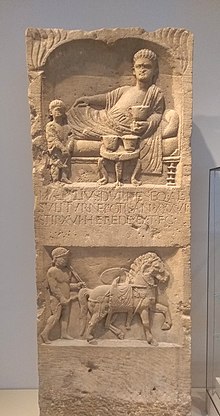Ala Sulpicia

The Ala Sulpicia [civium Romanorum] ( German Ala Sulpicia [the Roman citizen] ) was a Roman auxiliary unit . It is evidenced by military diplomas , inscriptions and brick stamps.
Name components
- Sulpicia : the Sulpic. The Ala was probably established by Galba , whose gentile name is Sulpicius , around 68 AD. If the Ala had been named after one of their first commanders (named Sulpicius ), Sulpiciana would be expected.
- civium Romanorum : the Roman citizen. The soldiers of the unit had been granted Roman citizenship at one point; possibly in connection with the suppression of the Batavian uprising . However, this did not apply to soldiers who were accepted into the unit after this point in time. They received Roman citizenship only with their honorable farewell ( Honesta missio ) after 25 years of service. The addition appears in military diplomas from 101 to 152, as well as in inscriptions.
Since there is no reference to the addition of milliaria (1000 men) to the name , the unit was an Ala quingenaria . The nominal strength of the Ala was 480 men, consisting of 16 towers with 30 riders each.
history
The Ala was stationed in the province of Germania . It is listed on military diplomas for the years 78 to 152 AD.
When the unit was set up by Galba around 68 AD, members of other units were probably assigned to serve as the core of the new Ala. This should explain why soldiers of the unit were dismissed from service after only 10 years. The unit probably belonged to the auxiliary units assigned to the Legio VI Victrix . The VI Legion was moved from Spain to the Rhine by Vespasian around 69/70 to take part in the suppression of the Batavian uprising under Julius Civilis ; the Ala was therefore probably moved to Germania together with the VI Legion .
The first evidence of unity in the province of Germania is based on a diploma dated 78. In the diploma, the Ala is listed as part of the troops (see Roman Armed Forces in Germania ) that were stationed in the province. Further diplomas, which are dated from 101 to 152, prove the unit in the province of Germania inferior .
The Ala was probably not in the province by 89. Domitian (81–96) had given the Roman armed forces in Germania inferior who remained loyal to him after the suppression of the uprising of Lucius Antonius Saturninus the honorary designation pia fidelis Domitiana ; but this addition is missing from the unit. A writing tablet dated to 90 shows the presence of an Ala rider in Vindonissa .
The last evidence of the Ala is based on an inscription that is dated to 187.
Locations
Locations of the Ala in Germania Inferior were possibly:
- Gelduba ( Krefeld-Gellep ): A brick with the stamp A SULP CR was found here.
- Wesseling
Members of the Ala
The following members of the Ala are known:
Commanders
|
|
Others
See also
Web links
literature
- Jan Kees Haalebos : Traian and the auxiliary troops on the Lower Rhine A military diploma from AD 98 from Elst in the Over-Betuwe (Netherlands) In: Saalberg Jahrbuch, 2000/50, pp. 31–72 ( online )
- Jörg Scheuerbrandt : Exercitus. Tasks, organization and command structure of Roman armies during the imperial era. Dissertation, Albert-Ludwigs-University Freiburg im Breisgau 2003/2004 ( PDF )
- John EH Spaul : Ala². The Auxiliary Cavalry Units of the Pre-Diocletianic Imperial Roman Army. Nectoreca Press, Andover 1994, ISBN 0-9525062-0-3
- José Ignacio San Vicente: Galba, el Ala Tauriana y el Ala Sulpicia. In: Hispania antiqua. Volume 31, 2007, pp. 87–110 ( online )
- Paul A. Holder : Exercitus Pius Fidelis: The Army of Germania Inferior in AD 89 In: Zeitschrift für Papyrologie und Epigraphik . Volume 128 (1999), pp. 237-250 ( PDF )
Individual evidence
- ↑ a b c John EH Spaul , Ala², pp. 209-210.
- ^ A b José Ignacio San Vicente, Galba, pp. 105, 109-110.
- ^ Inscriptions with civium Romanorum ( AE 1966, 187 , CIL 13, 1680 )
- ↑ Jörg Scheuerbrandt , Exercitus, p. 158 Table 2 (PDF p. 160).
- ↑ Military diplomas of the years 78 ( CIL 16, 23 ), 101 ( RMM 9 , ZPE-187-279 ), 127 ( AE 2010, 1865 , RMD 4, 239 ), 150 ( ZPE-206-207 ) and 152 ( RMM 35 , ZPE-148-262 )
- ^ Paul A. Holder , Exercitus Pius Fidelis, p. 249.
- ^ A b Jan Kees Haalebos , Traian, pp. 40-41 (online pp. 20-21).
- ↑ Inscription ( CIL 13, 8185 )